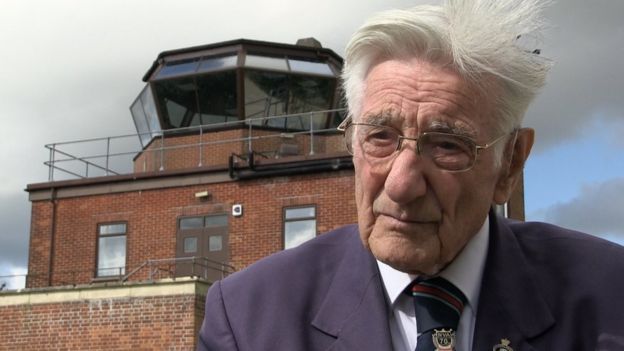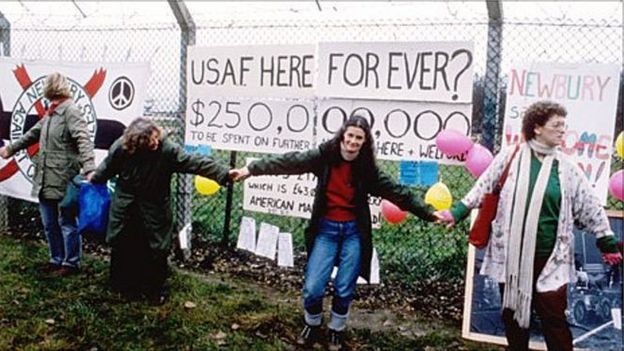The many faces of Greenham Common
From 1980 it housed 96 nuclear US warheads, which at one point prompted up to 35,000 women to join hands round the base in peaceful protest.
Now, 25 years after the US air force moved out of Greenham Common and 20 since it was returned to public use, a series of events are being held at the site to celebrate.
Here, we speak to some with lesser known stories about the base.

'Nuclear' panic
Gordon Smith was an electrician at Greenham Common in the years after World War II, when the US air force were stationed there. Now 92, he recalls a dramatic incident on 28 February 1958.

"The biggest fright we had was when a bomber took off to go back to America.
"The pilot lost control in very heavy winds. He was told to drop his fuel tanks... and he missed his target. One of the fuel tanks went through the roof of a hangar. There was a B47 bomber in there at the time, being serviced, that was destroyed.
"The Americans panicked and got in their cars and went down into the town. Most of them thought there was a nuclear bomb on board, but there wasn't. They all went down into Newbury and mingled with the crowd, because they thought they were going to be in this disaster."
The refugee
Greenham Common also housed Asian refugees from Uganda after leader Idi Amin expelled the entire Asian population in 1972. Pragna Hay was six when she came with her family.

"We were met by warm and friendly local volunteers. During our time at the camp we were sent to local schools and the local families would adopt an Asian family inviting them to their home once a week or so and doing activities with them, cooking meals and eating together.
"They would also visit their adopted families in the camp and bring treats for them. The community were very welcoming."
'Everything was American'
Fleet resident Steve Rains was allowed on to the air base during 1988 and 1989 to watch the American football team play on the high school field.

"As you came through the main gate it was like going out of England and into a different country. It became the USA, we even had to drive on their side of the road. We weren't allowed to shop in any of the shops but if we were, we could only spend dollars. Everything was American.
"We'd be told drive up to the flight line and drive on the runway. We watched the game, there were cheerleaders, and it was a whole group of Americans against another group of Americans so the standard of the football was really high. Apart from the fact that there was no 70-piece marching band it was pretty much the high school experience."
Protesters' welcome
Peace protester Lynette Edwell, of Newbury, was part of the camp from the time the first march came to Newbury in 1981.
 LYNETTE EDWELL
LYNETTE EDWELL
"I was there when the group of walkers came from Wales. We were there to welcome them.
"[At camp] in the evening when it was dark it was much quieter and we could sit round the fire, talking and cooking. Mainly we were there to see that the cruise convoy did not leave the base by any exit.
"We would line the route at different places all the way to Salisbury Plain.
"The MoD kept issuing statements saying there had been no demonstrations at all, so then we took to plastering the convoy vehicles with paint."



No comments